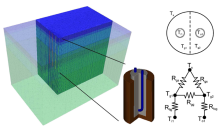TUBAF Joins Canadian Climate Resilience Research Initiative
TUBAF is contributing to the new Canadian initiative, Transforming Built and Urban Microclimates: Advancing Resilience Science for Vulnerable Populations in a Decarbonized and Electrified Canada, which aims to address the mounting impacts of climate change, including extreme weather, heat waves, and wildfires. This interdisciplinary project draws on expertise in engineering, urban microclimates, geomechanics, building science, AI/ML, MEMS, quantum computing, and public health to develop data-driven, practical strategies for improving urban and infrastructure resilience.
Supported by National Research Council Canada (NRC), Environment and Climate Change Canada (ECCC), and Natural Resources Canada (NRCan), the project is organized into five work packages covering data collection, AI-enabled modeling, applied adaptation measures, dissemination, and policy guidance. As part of its role, TUBAF will conduct geothermal simulations in Arctic regions, including permafrost soils, generating critical insights to enhance infrastructure stability under changing climatic conditions.
Through extensive data gathering, advanced modeling, and collaboration with indigenous and northern communities, the initiative will inform building codes, urban policies, and adaptation measures. This systematic approach helps shape resilient infrastructure, close key knowledge gaps in climate science, and facilitate the transition to decarbonized, electrified environments that safeguard vulnerable populations and ecosystems alike.

From: Zheng, T., Shao, H., Schelenz, S., Hein, P., Vienken, T., Pang, Z., Kolditz, O., & Nagel, T. (2016). Efficiency and economic analysis of utilizing latent heat from groundwater freezing in the context of borehole heat exchanger coupled ground source heat pump systems. Applied Thermal Engineering, 105, 314–326. https://doi.org/10.1016/j.applthermaleng.2016.05.158